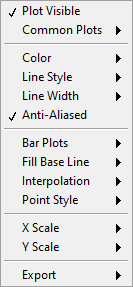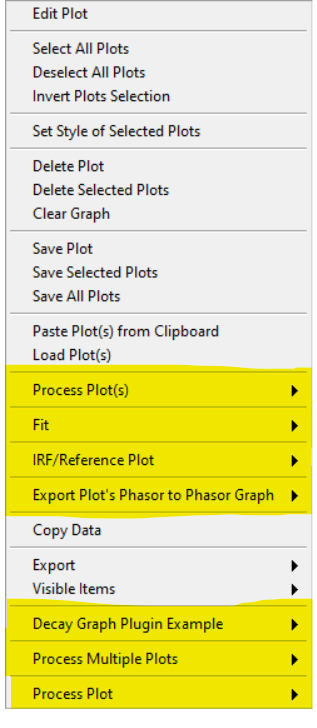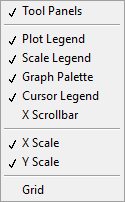Graph Object
Multiplot graph objects are ubiquitous in AlliGator and are packed with many functionalities. Not all functions are available in al graphs (it wouldn’t make sense to fit a decay model to an intensity histogram, for instance), therefore custom function descriptions will be found in page manuals dealing with each specific graph object. The following will hold for most graphs, with some exceptions.
Graph Object Anatomy
A graph oject is comprised of:
two or more graph scales
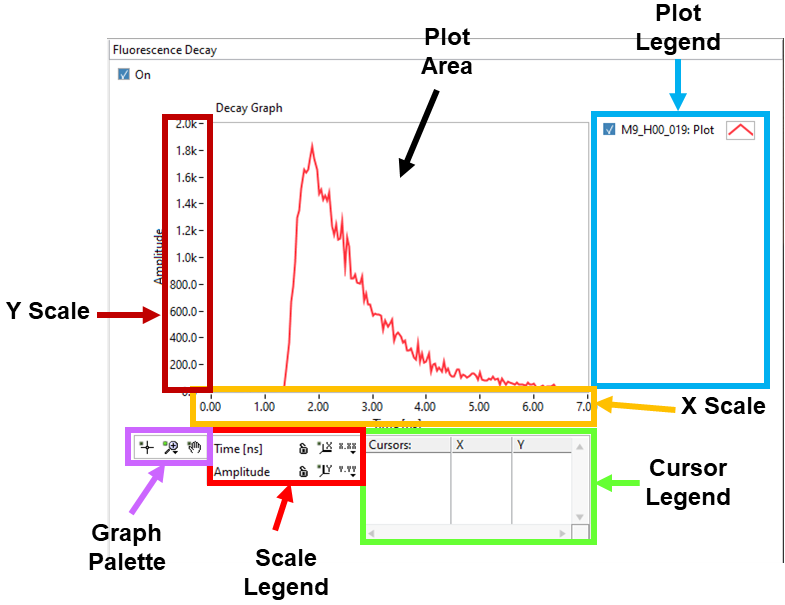
Plot Area
The plot area is the rectangular region in which plots are displayed. In the example shown above, a single plot is displayed, but in general, more than one plot will be present. The list of available plots is found on the right in the plot legend.
The apparence of the plot area can be modified in the following manner:
by modifying the range of displayed values (using the X and Y scales directly, or using the graph palette)
by showing or hiding grid lines (using the graph custom menu or the scale legend)
The different actions will be discussed in the respective object’s subsections below.
Plot Legend
The plot legend lists the plots stored in memory. Plot names do not need to be different, but it is easier to distinguish them if they are, especially when the list is long. In that case, a scrollbar will appear on the righthand side of the legend. Move the scrollbar up and down using the mouse wheel to show the name of all plots. Alternatively, use the Index Display control above the legend to select the index of the plot at the top of the list (the first plot has index 0).
Long plot names will not show up fully in the legend, but hovering over a plot name with the mouse will reveal a ‘tooltip’ with the full name of the plot.
Plot names can be edited by clicking in them.
Each plot’s name is preceded by a checkbox, which defines whether or not the plot is actually displayed in the plot area. These checkboxes are also used as ‘selection’ checkboxes to perform custom actions on multiple plots at once, such as for instance saving the selected plots or changing their style. In other words, when performing an action on selected plots, the unselected plots are not visible in the graph.
The small image on the right of each plot name (plot icon) can be clicked on (right or left button) to give access to the standard plot menu.
Graph Scales
Most graphs have a single X (horizontal) and Y (vertical) scale, but some may have two or more, on either side of the graph (top or bottom for the X scales and left or right for the Y scales).
The visible bounds (min and max) of each scale can be edited by clicking on their respective values. Likewise, the scale title can be modified by clicking on it and editing it.
Further modification can be performed using the Scale Legend.
Scale Legend
The Scale Legend comprises the scale title (editable), an autoscale lock button, a single-autoscale button and a scale options menu.
The autoscale lock enables the graph to adjust its range automatically when a plot is added, so that all selected plots are visible. If this is not desirable, click the button to disable the autoscale option.
The single-autoscale button allows applying autoscale once only.
Finally, the scale options menu shown below provides option to format the scale tick labels, set the displayed precision, and choose between linear and logarithmic scaling. It also enables hiding a scale or only its labels and select the grid color.
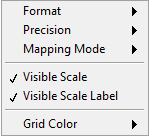
Graph Palette
The Graph Palette allows switching between tools to interact with the plot area:
cross: cursor manipulation
magnifying glass: zoom tools to adjust the plot area range(s)
hand: panning of the plot area
Cursor Legend
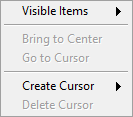
The Cursor Legend (or Cursor Table) shows the list of available cursors, to which individual cursors can be added (Create Cursor) or can be removed from (Delete Cursor).
The table also gives access to individual cursor properties (style, color, etc.) as well as associated plots, coordinates and plot value(s).
Finally, Bring to Center and Go to Cursor move the selected cursor to the center of the Plot Area or recenter the Plot Area on the selected cursor. The former provides a convenient way to locate a cursor and then fine-tune its location.
